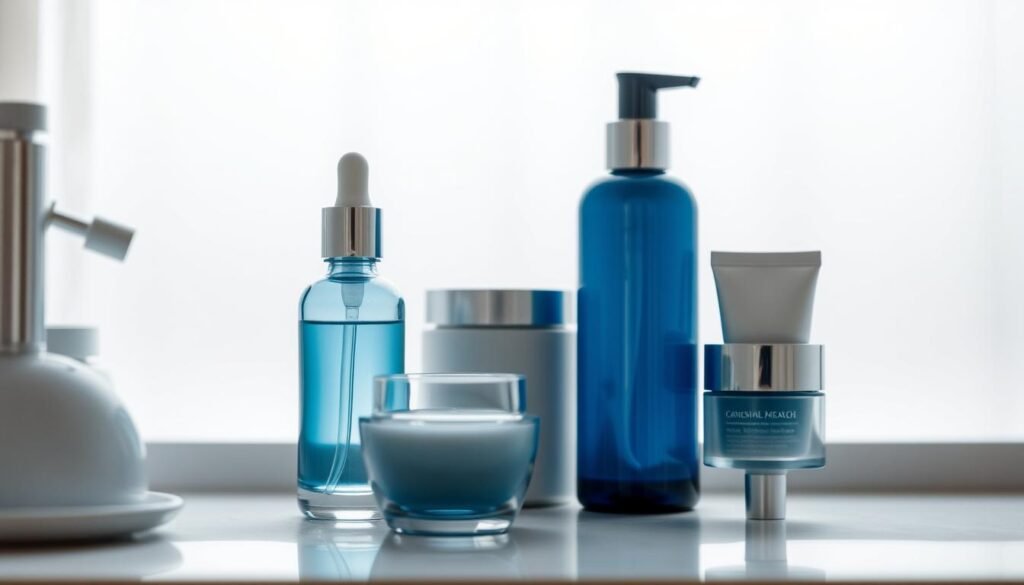Do you know how screens can harm your skin? In today’s digital age, we’re constantly exposed to blue light from smartphones, computers, and televisions.
This exposure can lead to premature aging and other skin issues. As we use more technology, it’s key to understand blue light’s impact on our skin. We also need to learn how to protect it.
With the right knowledge and simple tips, you can lessen digital skin damage from screens. This article will explore blue light’s effects on skin health. It will also offer practical advice on protecting your skin.
Key Takeaways
- Understanding the risks associated with blue light exposure
- Simple measures to protect your skin from digital damage
- Practical tips for incorporating skin protection into your daily routine
- The importance of being proactive about skin health in the digital age
- Effective ways to minimize the impact of tech on your skin
Understanding Blue Light and Its Sources
Blue light from digital devices is a big worry for skin health. As we use screens more, knowing about blue light and its skin effects is key.
What Is Blue Light?
Blue light is a high-energy visible (HEV) light with a wavelength of around 400-450 nanometers. It’s part of the visible light spectrum we can see. Prolonged exposure to blue light has been linked to digital eye strain and potential skin damage.
Where Does Blue Light Come From?
Blue light comes from many digital devices, including:
- Smartphones
- Computers and laptops
- Televisions
- Tablets and e-readers
These devices are everywhere in our lives, making blue light exposure common.
The Role of Technology in Blue Light Exposure
The rise of digital devices has increased our blue light exposure. As technology advances and becomes more part of our lives, blue light exposure grows. It’s important to understand how technology affects blue light exposure to protect our skin.
Some key statistics show the impact of technology on blue light exposure include:
| Device | Average Daily Use | Blue Light Emission |
|---|---|---|
| Smartphone | 4 hours | High |
| Computer/Laptop | 6 hours | Moderate to High |
| Television | 3 hours | Moderate |
By knowing where blue light comes from and how technology affects it, we can start protecting our skin from its harmful effects.
Impact of Blue Light on Skin Health
Spending more time in front of screens makes it key to know how blue light affects our skin. Blue light can harm skin cells, causing signs of damage from digital use.
Effects of Blue Light on Skin Cells
Blue light goes deep into the skin, harming skin cells and causing stress. This stress can break down collagen and elastin. These proteins are vital for keeping skin firm and elastic. Technology-driven skin care is now more important than ever to tackle these issues.
Signs of Digital Skin Damage
Blue light exposure can lead to skin problems like hyperpigmentation and loss of elasticity. It can also speed up aging. Using digital screen protection can help prevent these issues.
Comparison: Blue Light vs. UV Light
UV light is known for causing skin damage, but blue light is also a risk. Blue light can pass through windows and comes from digital devices. It’s important to understand the differences between blue light and UV light for effective blue light shield for skin strategies.
Both UV and blue light cause oxidative stress, but they come from different sources. UV light comes from the sun, while blue light is from digital devices. This shows the need for skin care that covers both UV and blue light exposure.
Recognizing Symptoms of Digital Skin Damage
Spending too much time in front of screens can harm our skin more than we think. Blue light from digital devices can cause several problems.
Common Signs to Look Out For
Digital skin damage shows up in different ways. Look out for:
- Dullness and loss of skin radiance
- Uneven skin tone and hyperpigmentation
- Increased sensitivity and redness
- Fine lines and wrinkles due to premature aging
Knowing these signs is the first step to protect your skin. Understanding how blue light affects your skin helps you reduce digital skin damage.
Long-Term Effects of Tech Exposure
Long-term use of digital devices can harm your skin health. Some long-term effects include:
| Effect | Description |
|---|---|
| Premature Aging | Blue light can make skin age faster, leading to wrinkles and fine lines. |
| Increased melanin production can result in uneven skin tone and dark spots. | |
| Skin Sensitivity | Prolonged exposure can make skin more sensitive and reactive. |
Using blue light skincare products daily can help. Products rich in antioxidants are especially important for protecting your skin.
By recognizing digital skin damage symptoms and understanding tech exposure effects, you can protect your skin. This helps keep your skin healthy and youthful.
Tips for Protecting Your Skin from Blue Light
Using digital devices more often means we need to protect our skin from blue light. It’s important to know how to lessen its impact on our skin.
Simple Daily Routine Changes
Small changes in your daily routine can help a lot. Try using blue light filtering glasses or apps that block blue light. Also, having a tech-free time before bed helps a lot.
- Use blue light filtering glasses or screen protectors.
- Enable night mode on your devices.
- Limit screen time before bed.
Incorporating Blue Light Defense Products
Adding blue light defense products to your skincare is key. Look for items with antioxidants and other protective ingredients. They help fight digital damage.
- Choose a serum or moisturizer with blue light protection.
- Apply sunscreen daily, even when indoors.
- Consider a face mask with antioxidants.
Choosing the Right Skincare Ingredients
Picking the right ingredients is crucial for blue light protection. Look for vitamin C, niacinamide, and plant extracts. They are known for their protective benefits.
| Ingredient | Benefit |
|---|---|
| Vitamin C | Antioxidant properties |
| Niacinamide | Improves skin elasticity |
| Plant Extracts | Soothes and protects the skin |
By following these tips and using the right products, you can protect your skin from blue light.
Essential Ingredients for Blue Light Protection
Understanding the key ingredients for blue light protection is crucial today. The right skincare can shield your skin from digital device harm.
Antioxidants: The Skin’s Best Defense
Antioxidants are vital in fighting blue light damage. They neutralize free radicals. Vitamin C and Vitamin E are strong antioxidants for skin health.
Adding antioxidant-rich products to your routine boosts your skin’s blue light defense. Look for serums and creams with antioxidants as main ingredients.
SPF: A Must-Have Even Indoors
Blue light isn’t the only concern; UV radiation from devices also harms skin. Daily use of a broad-spectrum SPF protects against UVA and UVB rays, even indoors.
Opt for a lightweight SPF that fits your skin type. Wear it under makeup or alone for best protection.
Natural Ingredients to Consider
Certain natural ingredients help protect against digital damage. Green tea extract and niacinamide soothe and repair the skin.
When choosing skincare for the digital age, look for products with natural ingredients, antioxidants, and SPF. This offers comprehensive protection.
Lifestyle Changes to Support Skin Health
In today’s world, protecting your skin from blue light damage is key. We need to change our lifestyle to keep our skin healthy. With more technology, our skin faces new challenges.
Reducing Screen Time Effectively
One simple way to cut down on blue light is to use your devices less. Try not to use screens during meals or an hour before bed.
- Make some areas in your home screen-free, like the bedroom or dining area.
- Use apps or built-in features to track and limit your screen time.
- Take regular breaks from screens during the day.
Creating a Tech-Free Environment
Having a tech-free area can help reduce blue light and improve your skin. It’s about choosing wisely when and where to use technology.
Here are some tips:
| Strategy | Description | Benefit |
|---|---|---|
| Device-Free Zones | Make some areas or times of the day screen-free. | Less blue light exposure. |
| Blue Light Filtering | Use glasses, apps, or software to block blue light. | Less digital skin damage. |
| Outdoor Activities | Do more outdoor activities to cut down on screen time. | Better overall health and less screen time. |
Daily Skin Care Rituals to Adopt
Having a regular skincare routine is crucial for healthy skin, even with blue light. Cleanse, moisturize, and use products that fight digital skin damage.
Look for these key ingredients:
- Antioxidants to fight free radicals from blue light.
- SPF to protect against UV damage, made worse by blue light.
- Natural ingredients to soothe and repair your skin.

Best Blue Light Protection Products on the Market
More people are worried about blue light’s impact on their skin. The skincare world has come up with many products to fight digital skin damage. It’s important to pick a product based on the brand’s reputation and what’s in it.
Top-Rated Skincare Brands
Many top skincare brands now offer blue light protection products. Some well-known brands include:
- La Roche-Posay: Known for their antioxidant-rich products that help protect the skin.
- Dermalogica: Offers a range of products with ingredients that combat the effects of blue light.
- Dr. Dennis Gross Skincare: Provides products with advanced formulations to protect against digital damage.
These brands are praised for their effective products and dedication to skin health.
Key Product Features to Look For
When picking a blue light protection product, look for these key features:
- Antioxidant Content: Antioxidants are key in fighting free radicals from blue light.
- SPF Protection: SPF helps protect against other environmental stressors, even though blue light isn’t UV.
- Natural Ingredients: Ingredients like green tea and vitamin C are great for protection.
By focusing on these features, you can choose the best skincare for blue light protection.
The Role of Diet in Skin Protection
Eating the right foods can help fight digital skin damage. A diet full of essential nutrients protects your skin from blue light harm.
Foods That Help Combat Digital Damage
Adding certain foods to your diet boosts your blue light defense. Antioxidant-rich foods like berries, leafy greens, and fruits and veggies fight free radicals from blue light. Nuts and seeds, with their healthy fats and antioxidants, also benefit your skin.
Foods with omega-3 fatty acids, like salmon and walnuts, lower inflammation from screens. Vitamin C-rich foods, such as citrus fruits and bell peppers, help repair your skin.

Hydration: The Foundation of Healthy Skin
Drinking enough water is key to healthy skin. It keeps your skin hydrated and strong against digital damage. Adequate hydration also helps your skin’s natural barrier, reducing dryness and irritation from blue light.
Drinking water and eating hydrating foods like cucumbers, watermelon, and celery boosts hydration. A hydrated body fights digital screen stress better, supporting digital screen protection.
Keeping a balanced diet and staying hydrated are simple ways to protect your skin from blue light. By choosing what you eat and drink wisely, you boost your skin’s natural defenses.
DIY Recipes for Blue Light Protection
Adding DIY skincare recipes to your routine can help fight blue light’s harm to your skin. Natural ingredients in these recipes protect and nourish your skin.
Easy-to-Make Face Masks
Face masks offer a deep dose of protection and care for your skin. Here are easy recipes to try at home:
- Turmeric and Honey Mask: Mix 1 teaspoon of turmeric powder with 1 tablespoon of honey. Turmeric fights inflammation, and honey moisturizes.
- Avocado and Oatmeal Mask: Mash 1 ripe avocado and mix it with 2 tablespoons of oatmeal. Avocado hydrates, and oatmeal calms the skin.
Homemade Serums for Tech Skin
Serums are strong products for specific skin issues. For blue light protection, use antioxidants:
- Green Tea Serum: Steep a green tea bag in 1 ounce of boiling water, then cool it. Mix it with 1 ounce of aloe vera gel. Green tea’s antioxidants fight digital damage.
- Vitamin C Serum: Mix 1 teaspoon of vitamin C powder with 2 tablespoons of distilled water. Vitamin C brightens and protects against environmental stress.
As “The future of skincare is not just about treating the skin, but about protecting it.” Using these DIY recipes helps protect your skin from tech harm. This keeps your skin healthy and strong.
The Future of Skincare and Technology
The skincare world is on the verge of a big change, thanks to technology. With more screen time, protecting our skin from blue light is key. The future of skincare is about preventing problems with new tech solutions.
Innovations in Blue Light Skincare
The skincare industry is seeing a lot of new ideas to fight digital skin damage. Technology-driven skin care products are being made with special ingredients. These ingredients help fight blue light effects.
Some of the main new ideas include:
- Products with antioxidants to reduce blue light stress.
- Skincare with ingredients that absorb or reflect blue light.
- Advanced systems to get active ingredients deeper into the skin.
Impact of Emerging Technologies on Skin Health
New tech like AI and nanotechnology will change skincare. AI can make skincare routines fit your skin type and needs. Nanotechnology can make active ingredients work better.
These techs will be key in improving digital age skincare. Some benefits include:
- Custom skincare products for each person.
- Better delivery of active ingredients with nanotechnology.
- AI to predict and prevent skin problems.
As tech keeps getting better, it’s important to know about new blue light skincare. By using these new ideas, we can protect our skin from blue light. This helps keep our skin healthy and strong.
Conclusion: Your Action Plan for Healthy Skin
Understanding how blue light affects our skin is key. It’s important to protect our skin from digital damage. By knowing where blue light comes from and how it harms skin cells, we can start to fix the problem.
Key Strategies for Protection
Using blue light skincare products is a good start. Also, try to spend less time in front of screens and make tech-free zones at home. Adding antioxidants and SPF to your skincare routine can also help fight digital damage.
Embracing a Balanced Tech Life
Healthy skin needs a mix of tech use and good skincare. Being smart about our tech habits and choosing the right skincare can help. Begin your path to better skin by focusing on blue light protection and tech skin care.



